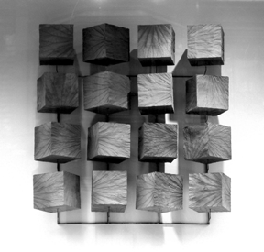|
The
Boston Globe Moving
studies of fragility |
|
 |
 |
| by
CATE MCQUAID, GLOBE CORRESPONDENT |
Left: Steve hollinger’s sculpture “Sixteen Leaf Boxes” showcases the obsessive care and detail the artist puts into his work. Right: a detail from Hollinger’s “Man with Flowers,” a juxtaposition of old-fashioned contraption and modern solar power. |
Sculpture
is the most tangible of the visual arts, but Steve Hollinger's sculptures
at Chase Gallery strive to embody the intangible. They're kinetic and interactive;
many of them run on solar power or depend on the merest breath of wind to
activate. Often, they depict love or fear -- humanity's fragility in the face
of honesty or strength.
In these latest works, Hollinger makes great use of the figure -- usually
a man, depicted in a silhouette of light. ''Man With Flowers" takes off
from 19th-century photographer Edweard Muybridge's studies of motion. A wheel
turns within a black box mounted on the wall; Hollinger has stamped little
figures out of the copper rim of the wheel. As the rim passes before an eye-level
screen set before a hole opening to the sun, we see the figure projected on
the screen. He kneels, then holds up a bouquet of flowers. It's an image of
sweetness coming from an elegant contraption that is in some ways a throwback
to early-20th-century moving pictures, except that it is solar powered, heralding
the future.
''Cenotaph" operates like an illuminated flipbook. The viewer steps on
a pedal to turn the light on and activate the sculpture, then looks through
a clear prism to see the rush of images: a spear carrier practicing his moves
against a changing background that includes landscapes, a crowded street,
and an exploding mushroom cloud. The figure evokes a soldier throughout history;
he might be the undercurrent of war that runs through our psyches even in
the most placid times.
Hollinger's concern with fragility comes through most in two sculptures he
made largely out of lotus leaves. He fashioned cubes from the leaves and positioned
them on brass axles. Walk past, and the air current of your motion wafts over
the grid of leaf cubes, setting them in gentle and unpredictable rotation.
They speak to the obsessive care and detail that this artist puts into his
art, occasionally operating on a minute scale, or working with material so
delicate it's hard to imagine how it has survived. He encases many of his
pieces in wood boxes, and they are quite sturdy, but that doesn't interfere
with Hollinger's take-home message: Honor what is precious and fleeting. It
may only show up in a shaft of sunlight and disappear, but that makes it all
the more rare and wonderful.
This
story ran on page E16 of the Boston Globe on 12/8/2004.
© Copyright 2004 Globe Newspaper Company.
To view this article in the Globe archives, click here.